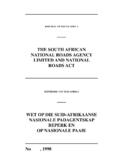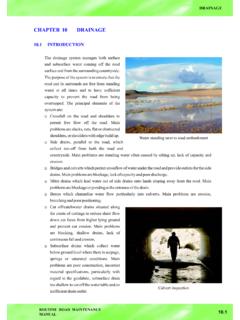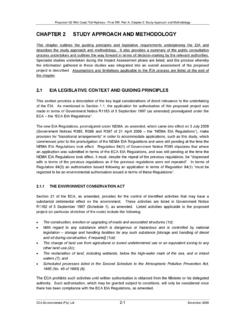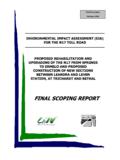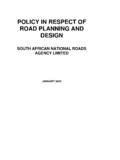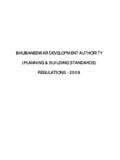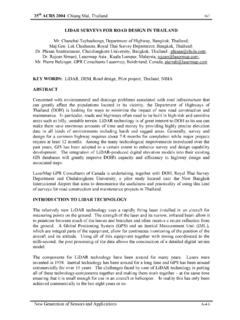Transcription of PROCEDURES FOR ROAD PLANNING AND GEOMETRIC DESIGN - nra.co.za
1 PROCEDURES for road PLANNING and GEOMETRIC DESIGN May 2003 1 PROCEDURES FOR road PLANNING AND GEOMETRIC DESIGN SOUTH AFRICAN NATIONAL ROADS AGENCY LIMITED JANUARY 2003 PROCEDURES for road PLANNING and GEOMETRIC DESIGN May 2003 2 PROCEDURES FOR road PLANNING AND GEOMETRIC DESIGN 1) GENERAL a) Relevance This document explains the PROCEDURES required to be followed by Applicants applying to the SANRAL for approvals and permissions, and guides planners and designers working on SANRAL projects. It compliments the SANRAL Policy in respect of road PLANNING and DESIGN , as well as provides a background, where applicable, to the use of the SANRAL GEOMETRIC DESIGN Guidelines. b) Philosophy The SANRAL wishes to ensure that Applicants requiring approval or permission from the SANRAL are well informed of the requirements of the SANRAL in respect of the facilities, accesses or developments proposed.
2 At the same time, Applicants need to be aware of the processes which they need to follow and information they need provide to enable the SANRAL to arrive at consistent and fair decisions. The PROCEDURES for road PLANNING and DESIGN are also provided to assist road planners and designers to ensure that they meet with the expectations of the SANRAL. c) Application of these PROCEDURES The PROCEDURES for road PLANNING and GEOMETRIC DESIGN have been prepared as a guideline to remove uncertainty and doubt regarding the requirements to be met and PROCEDURES to be followed by Applicants proposing facilities, accesses and developments on or alongside National Roads. For planners and designers, the PROCEDURES elucidate the Policy and provide additional guidance. The PROCEDURES reflect the most basic and general requirements of the SANRAL, and in no way limit the SANRAL, or prevent it to require further information, impose further conditions to those stated in this document, or to relax any condition or requirement contained herein as circumstances, in the opinion of the SANRAL, may require.
3 2) ENVIRONMENTAL PROCEDURES Introduction: Required Authorisations For certain kinds of relatively minor roadworks, the SANRAL is not required by the Environmental Authorities to perform an Environmental Impact Assessment, whilst for those projects which involve major works, environmental considerations are of great importance, and need to comply with all aspects of Environmental Legislation. Each kind of roadworks is dealt with separately, below; a) Routine Maintenance Routine maintenance conducted within the road reserve does not require the performing of an Environmental Impact Assessment in terms of the Environmental Impact Assessment regulations. b) Periodic Maintenance Periodic maintenance conducted within the road reserve does not require the performing of an Environmental Impact Assessment in terms of the Environmental Regulations.
4 C) Special Maintenance Special maintenance conducted within the road reserve may not require the performing of an Environmental Impact Assessment in terms of the Environmental Regulations. PROCEDURES for road PLANNING and GEOMETRIC DESIGN May 2003 3 d) Rehabilitation Rehabilitation conducted within the road reserve does not require the performing of an Environmental Impact Assessment in terms of the Environmental Regulations. Although none of the above-mentioned forms of work need authorisation from the Environmental Authorities, due consideration must be given to sound environmental management practices during the course of carrying out the work, as all Environmental Laws are still binding. The SANRAL s generic Environmental Management Plan (EMP) must be attached to the tender documents, as a result. e) Upgrading of Roads Where upgrading work extends beyond the road reserve boundary, or where the traffic bearing capacity of a road is increased within the existing road reserve, the SANRAL s Environmental Manager will consider if it may be possible to apply to be exempted from performing an Environmental Impact Assessment.
5 Should exemption be granted, the SANRAL s generic Environmental Management Plan must be included with the tender documentation and be implicitly adhered to. However, exemption from the Environmental Impact Assessment process does not mean exemption from all relevant environmental laws, and sound environmental management PROCEDURES should still be followed. f) Greenfield projects For all new roads, an Independent Environmental Consultant must be appointed to manage the process of obtaining authorisation from the relevant Environmental Authorities. The Independent Environmental Consultant shall conduct an Environmental Impact Assessment including a proper, transparent public participation process, as part of the environmental studies. g) Integration of the Environmental Process with the Technical DESIGN process i) Project Proposal Stage Project Phase Needs statement and project proposal formulated.
6 Environmental phase Establish if an environmental authorisation is required. If required, appoint an Independent Environmental Consultant, and arrange a pre-application meeting to discuss application requirements. During the project proposal and needs assessment phase, the necessity for an environmental authorisation must be established in consultation with the SANRAL s Environmental Manager. If an Authorisation is required, an Independent Environmental Consultant must be appointed to conduct the Environmental Impact Assessment. Hereafter a pre-application meeting must be convened with the Environmental Authorities. The Engineering Consultants must attend this meeting in order to supply technical information regarding the project. Following the pre-application meeting, any required information, as well as the appropriate application forms need to be submitted to the Environmental Authorities.
7 H) Route Location Stage Project phase Route Locations identified Environmental phase Scoping phase commences The various alternative and preferred route locations need to be finalised in order to allow the Independent Environmental Consultant to define the work to be included in the Scoping process. The Scoping phase is the first phase of an Environmental Impact Assessment process and is undertaken PROCEDURES for road PLANNING and GEOMETRIC DESIGN May 2003 4 to identify issues and determine which require further investigation. The Independent Environmental Consultant must complete a Plan of Study for Scoping for submission to the Environmental Authorities. This Plan must define the scope of the project, the proposed approach to the Scoping Study and the manner in which the consultant intends to deal with the alternatives presented.
8 The Public Participation Process forms an important component of the Environmental Scoping Study process. The Consulting Engineers must attend meetings together with the Independent Environmental Consultant. It is also important to note that the Scoping phase should not be considered purely as a mitigation exercise, but rather as one incorporating environmental issues into the DESIGN , thereby ensuring that the road is constructed and operated in the most sustainable manner. i) Basic PLANNING Stage Project phase Basic PLANNING commences incorporating findings of Scoping Report Environmental phase Scoping completed Once the Scoping Report has been accepted by the Environmental Authorities and the interested and affected parties, the Environmental Impact Assessment phase can commence in conjunction with the preliminary DESIGN of the road , incorporating the environmental issues/mitigation contained in the Scoping Report.
9 Following acceptance of the Scoping Report by the Environmental Authorities, a Plan of Study for the Environmental Impact Assessment should be prepared and submitted to the Environmental Authorities for approval. On acceptance of the Plan of the Study for the Environmental Impact Assessment, the Environmental Impact Assessment can commence. This usually includes a number of specialist studies depending on the issues identified in the Scoping Phase. Specialists in the necessary fields carry out the required investigations, which typically include a quantification of the various risks involved with each given development and the proposing of alternative practices and measures to minimise or eliminate negative impacts, and to enhance the positive impacts. The Public Participation Process must continue throughout this phase.
10 The findings of the specialists studies, relevant available information and information regarding the characteristics and requirements of the proposed alternatives are integrated by the Consultant into an Environmental Impact Report. This report contains key information from each of the specialist studies, including the description and assessment of impacts in terms of their significance of extent, duration, intensity and probability of occurrence. j) Final DESIGN Stage Project phase Final DESIGN commences after obtaining of the Record of Decision. Environmental phase Environmental Impact Assessment phase completed with Record Of Decision. When the Environmental Impact Report has been approved by the Environmental Authorities, a Record of Decision (ROD) will be issued. The final DESIGN stage can then commence, and must incorporate the recommendations made in the Environmental Impact Report.

